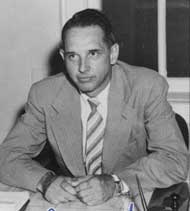Key Points:
- In 1936 John Atanasoff and physicist Glen Murphy built a small analog calculator called the Laplaciometer, which was used for analyzing the geometry of surfaces.
- Atanasoff conceived base-two numbers (the binary system) when all other known systems at the time used base-ten.
- Atanasoff received funding from Iowa State College to work on an automatic digital computer called ABC, with the assistance of Clifford Berry.

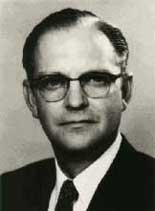
The ABC of John Atanasoff and Clifford Berry
Working on his doctoral thesis in theoretical physics at the University of Wisconsin in 1929, the young John Vincent Atanasoff (see biography of John Atanasoff) first time met a serious computational problem, being forced to perform complex calculations, using computing tools like slide rule and mechanical calculator Monroe type
After returning to Iowa State College in 1930 as an assistant professor in mathematics and physics, he started doing experiments with vacuum tubes and radio and examining the field of electronics. After examining many mathematical devices available at the time, Atanasoff concluded that they fell into two classes—analog and digital. Since the term “digital” was not used until much later, Atanasoff contrasted the analog devices to what he called “computing machines proper.” Sometimes in 1935, he began to think seriously about methods of mechanizing digital calculation. In 1936 Atanasoff constructed (along with his colleague physicist Glen Murphy), a small analog calculator, called Laplaciometer. It was used for analyzing the geometry of surfaces. Atanasoff regarded this machine as having the same flaws as other analog devices, where accuracy was dependent upon the performance of other parts of the machine.
Atanasoff spent a large portion of his time during the 1935-37 period modifying an IBM tabulating machine to solve sets of linear equations by the elimination procedure. He wrote a paper, Solution of Systems of Linear Equations by the Use of Punched Card Equipment, and a drawing for it, schematic Sketch of Auxiliary Apparatus, and in April 1937, he wrote a letter to IBM concerning this idea (later on, during the trial, an internal letter of IBM was revealed, saying in effect “…keep Atanasoff out of the tabulator.” In the 1930s IBM was not in the computer business, but in the office machines business.). Atanasoff had success in modifying an IBM tabulator for the analysis of spectra, that’s why he tried to use it for sets of equations. Ultimately he abandoned the scheme as impractical, primarily because of the machine’s limited storage capacity.
The obsession with finding a solution to the computer problem had built into a frenzy in the winter months of 1937. One cold night, frustrated after many discouraging events, Atanasoff got into his car and started driving to the east. Later on, he will tell in an interview: “It was at an evening of scotch and 100 mph car rides, when the concept came, for an electronically operated machine, that would use base-two (binary) numbers instead of the traditional base-10 numbers, condensers for memory, and a regenerative process to preclude loss of memory from electrical failure.” After driving two hundred miles, he pulled onto a roadhouse in the state of Illinois. Here, he had a drink of bourbon and soda (he was very fond of fast cars and scotch, and at this time Iowa was still a dry state, so let’s drive to Wisconsin:-) continued thinking about the creation of the machine. No longer nervous and tense, Atanasoff realized that these thoughts were coming together clearly. He began generating ideas on how to build this computer, using the back of a cocktail napkin. He envisioned a machine which:
• Use base-two numbers (the binary system)—all other known systems at the time used base-ten
• Use electricity and electronics as its principal media
• Use condensers for memory and use a regenerative process to avoid lapses that could occur from leakage of power
• Compute by direct logical action rather than by the enumeration methods used in analog calculators

By early 1938, Atanasoff had conceived the general electronic and logical design of an automatic digital computer for solving large sets of simultaneous linear equations and started to ask for financing. In March 1939 he applied and 2 months later received a grant of $650 ($200 for materials; $450 for Clifford Berry) from Iowa State College for construction of the machine. Asking for an assistant, Atanasoff received a recommendation from his colleague and friend Harold Anderson (professor of electrical engineering) for a particularly bright electrical engineering student, Clifford E. Berry, and after a short meeting he decided to hire him sometime in the spring of 1939. The construction of the prototype moved ahead with great speed and as soon as it was completed it worked well.
In late 1939 Atanasoff filled an application for funding to Iowa State College, and in December 1939 made a demonstration of the prototype to Iowa State College officials, which convinced them that Atanasoff’s project was worthy of a grant of $5000 from the Iowa State College Research Council to construct a full-scale machine capable of solving systems of equations.
Work on that machine started at the beginning of 1940. By late spring 1940, the machine was well on its way to completion, and they submitted a manuscript describing the details of the computer, both for obtaining a patent (which would never be filed by Iowa State College) and to apply for additional funding for refinement and perfection of the construction and operation features. The machine was manufactured in the basement of the Physics Building of Iowa State University (see the nearby photo) and was ready by the end of 1941. As the building of the machine continued, Clifford Berry wrote a manual for the ABC
Test runs proved that the full arithmetic unit and the two-drum store worked perfectly, as did most of the supporting components of the input-output system. Only the electronic card-writing and card-reading method, which Atanasoff had invented for intermediate storage of the newly computed sets of equations, failed sporadically. Its failure rate of less than one in ten thousand instances was still high enough to spoil results for large sets of equations. As it happened, the United States entry into World War II in December 1941, and soon both Atanasoff (in September 1942) and Berry (in July 1942) had to leave Iowa State before the difficulty with this particular procedure could be resolved.
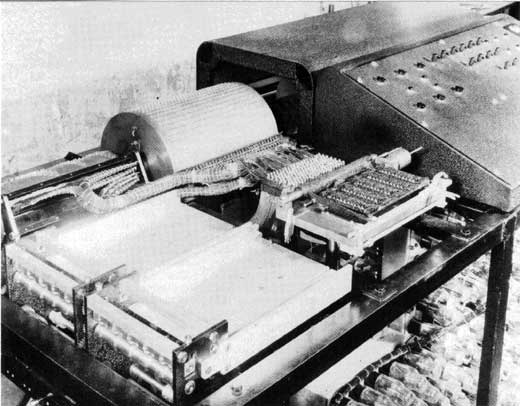
At the end of 1948, on one of his return visits to Ames, Atanasoff was surprised and disappointed to learn that his computer had been removed from the Physics Building and dismantled. Neither he nor Clifford Berry had been notified that the computer was going to be destroyed. Only a few parts of the computer were saved (one of the two memory drums, shown in a lower photo).
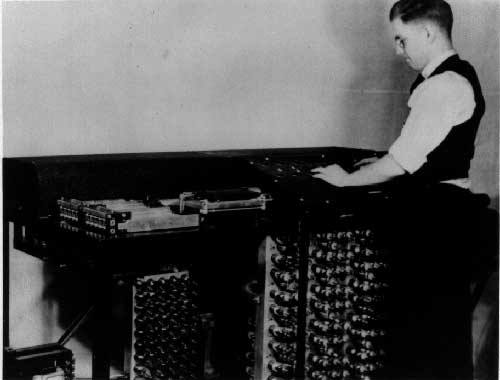
By late spring of 1940, the project was well underway, and consideration was given to the fact that steps needed to be taken to patent the machine, as well as requesting additional funding for its completion. A 35-page manuscript Computing Machines for the Solution of Large Systems of Linear Algebraic Equations, complete with drawings of the machine, was written by Atanasoff, with Berry’s assistance. One copy of this manuscript was sent in late 1940 to Chicago patent lawyer, Richard R. Trexler, who had been hired by Iowa State College to give them advice on how to protect the inventions that were incorporated into the computer. When in 1941 the work on the computer came to a halt and Atanasoff left Ames, to receive a defense-related position at the Naval Ordnance Laboratory in Washington, D.C., he left the task of completing the patenting of the ABC to university officials. This will proved to be one of the biggest mistakes in his life, as we will see later on.

Atanasoff never did earn any money from his invention. He said “I wasn’t possessed with the idea I had invented the first computing machine. If I had known the things I had in my machine, I would have kept going on it.” After his retirement in 1961, he used to work on private projects, when in the spring of 1967 he was contacted, to his surprise, by the attorneys of three huge computer companies — Control Data Company (CDC), Honeywell, and General Electric, regarding controversy with the Sperry Rand Corporation over what was called generally “the ENIAC PATENTS”. The inventors of the computer ENIAC — John Mauchly and J. Presper Eckert applied for the patent of his machine in 1947, the patent was granted in 1964. Meanwhile, Sperry Rand had purchased the company of Mauchly and Eckert and together with the company—the patent rights, so not only Honeywell but all the companies, manufacturing electronic computers, were supposed to pay patent fees. The lawyers of Honeywell and Control Data somehow managed to learn about the computer of Atanasoff. Until this moment the computer of Atanasoff has been mentioned only in 3 short newspaper messages from the 1940s (see the upper photo), and in the book Electronic Digital Systems of R. K. Richards, published in 1966. Richards was an Ames friend of Berry, who had seen the Atanasoff machine in 1941, so his book was probably the source of information for the attorneys.
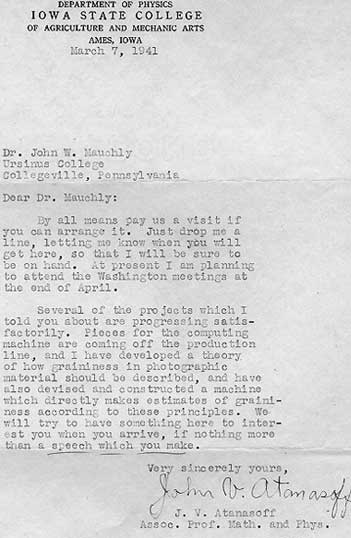
Atanasoff was hired as a consultant by CDC and Honeywell, provided all available information, and agreed to be a witness at the court trial, which started in 1971. In this trial, CDC and Honeywell, with the determinant help of Atanasoff managed to prove, that Mauchly and Eckert have used ideas from the ABC, the patent pretensions of Sperry Rand have been rejected, and the patent of Mauchly and Eckert was classified as invalid. During this long trial (it lasted 135 working days, and filled more than 20000 pages of transcript with the testimony of 77 witnesses), Atanasoff made a very good impression with his manners and testimony, in contrast with Mauchly’s shameful display, who changed his testimony under oath three times, and spoke slightingly for Atanasoff and his computer. It was proved, that during his first meeting in December 1940, Atanasoff described his work to Mauchly, and as Mauchly wanted to see the ABC for himself, Atanasoff agreed and invited him to visit him in Iowa (see the nearby photo for a letter from John Atanasoff to Mauchly, dated 7th of March, 1941). Bit by bit Mauchly was persuaded by the attorneys to confirm the following points:
1. He spent from 13 June 1941 to the morning of 18 June 1941 as a guest in Atanasoff’s home in Ames.
2. During this period as Atanasoff’s guest he spent uncounted hours in discussions of the Atanasoff Berry Computer and computer theory with John Atanasoff and Clifford Berry.
3. On three or four days he accompanied Atanasoff to his office in the Physics Building and observed the Atanasoff Berry Computer in the company of Atanasoff and Clifford Berry.
3. He had seen demonstrations of the operations or some phases of the functions of the ABC and might have engaged in manipulation of some parts of the machine with Clifford Berry.
4. He was permitted to read Atanasoff’s 35-page manuscript on the construction and operation of the ABC from cover to cover and probably did read it. Atanasoff and Berry had willingly answered questions and entered into discussions with him about the machine and the booklet, but Atanasoff had refused to let him take a copy to Pennsylvania.
5. Immediately after his visit to Iowa State in June, Mauchly had written letters to Atanasoff and to his meteorologist friend, Helms Clayton, expressing enthusiasm about the Atanasoff Berry Computer and had taken a crash course in electronics at the University of Pennsylvania.
6. On 15 August 1941 he wrote a comprehensive memorandum on the difference between analog calculators and pulse devices that incorporated some ideas that were almost identical to those in Atanasoff’s 35-page manuscript on the ABC.
7. On 30 September 1941 he had written to Atanasoff suggesting a cooperative effort to develop an Atanasoff computer and had asked if Atanasoff had any objection to him using some of the Atanasoff concepts in a computer machine, that he was considering building.
When Judge Larson distributed the formal opinion on 19 October 1973, it was everything that the attorneys of CDC and Honeywell and Atanasoff himself had hoped it would be. It was clear and unequivocal finding that Mauchly’s basic ENIAC ideas were “derived from Atanasoff, and the invention claimed in ENIAC was derived from Atanasoff.” In extensive findings, Judge Larson declared: “Eckert and Mauchly did not themselves first invent the automatic electronic digital computer, but instead derived that subject matter from one Dr. John Vincent Atanasoff.”
Judge Larson had ruled that John Vincent Atanasoff and Clifford Berry had constructed the first electronic digital computer at Iowa State College in the 1939-1942 period. He had also ruled that John Mauchly and J. Presper Eckert, who had for more than twenty-five years been feted, trumpeted, and honored as the co-inventors of the first electronic digital computer, were not entitled to the patent upon which that honor was based. Furthermore, Judge Larson had ruled that Mauchly had pirated Atanasoff’s ideas, and for more than thirty years had palmed those ideas off on the world as the product of his own genius.
Let’s examine the purpose and construction of the ABC (the name ABC-Atanasoff-Berry Computer is not the original name of the machine, Atanasoff adopted this name in recognition of Berry’s contribution to it during the litigations at the end of the 1960s).
ABC was about the size of a desk and weighed about 315 kg (see the lower scheme). It contained 280 vacuum tubes and 31 thyratrons.
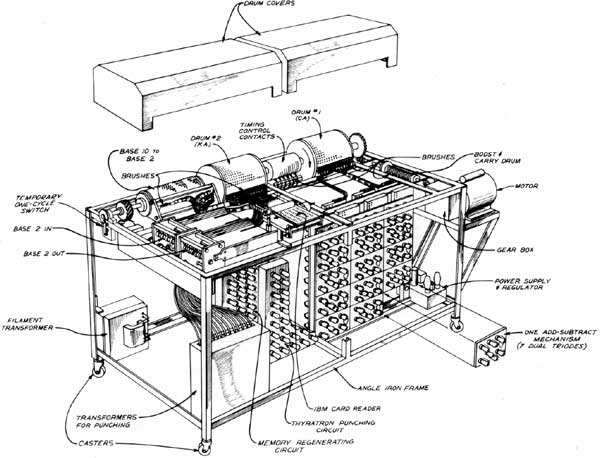
ABC was a specialized computing machine for the solution of large systems of linear algebraic equations (up to twenty-nine equations in twenty-nine unknowns, with each of the thirty coefficients (including constant term) of each equation having about fifteen decimal places), using the standard Gaussian elimination algorithm. Atanasoff’s idea was the following: he would solve a large set of equations by eliminating a designated variable from successive (overlapping) pairs, thereby generating a new set in one fewer variable, then repeating the process for the new set, and so on, until finally a single equation in a single variable emerged. He could then find single equations in all the other variables, as well, and so calculate the value of every variable.
The structure and principles of operation of ABC are very simple. The machine consists of three basic parts: a storage device, an arithmetic unit, and an input/output unit.
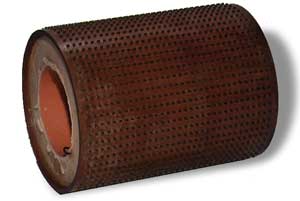
For the storage device, Atanasoff considered many possibilities, conducting numerous tests and experiments, in the end, he chose to use for the memory a rotating electrostatic store — drum, based on capacitors. So-called keyboard and counter drums (the nearby photo is of the only surviving part of the ABC — one of the two drums) are mounted on a common axle, each eleven inches long and eight inches in diameter (the drums contained 1600 capacitors each). Each drum holds 30 numbers of 50 bits each. (Two of the columns are spares). Drums are operated in parallel. It is the first use of the idea we now call DRAM — the use of capacitors to store 0s and 1s, refreshing their state periodically.
The source digits from the punch card reader are stored on Drum #1. The contents of Drum #1 could be transferred to Drum #2. When all operands are stored on Drum #1 and Drum #2 the ABC was ready for computations. Each computation (addition or subtraction) was completed on digits from Drum #1 and Drum #2 and the result was stored on Drum #1. When the computations were finished the contents of Drum #1 were punched on cards. He would have a memory separate from the arithmetic unit, in the form of two drums turning on a common axle, each drum large enough to store the coefficients of one equation in capacitor elements. The coefficients of any given pair to be processed would be fed simultaneously into the electronic arithmetic unit and operated on to eliminate a designated coefficient from one of them. The new equation thus formed would be recorded on a card as one of the next smaller set, to be reentered in the next round of eliminations.
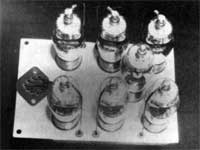
Atanasoff’s arithmetic unit is based on vacuum tubes and consists of thirty computing mechanisms together with several control mechanisms. Each of the computing mechanisms, which Atanasoff had expected to be electronic counters with some kind of carrying arrangement. That is, the thirty computing mechanisms consisted of thirty electronic add-subtract mechanisms (each contains 7 dual triodes) (see the nearby photo), thirty other primarily electronic mechanisms, and the thirty electrostatic bands of a carry-borrow drum.
For input device is used existing punch card reader of IBM Corp (there are two readers: decimal and binary). For the output device, however, Atanasoff devised a high-voltage thyratron-based puncher, which seems to be a failure. During the experiments with the machine in the summer of 1942 the only serious flaw appeared namely in the output puncher. The writing mechanism consisted of two sets of thirty tungsten electrodes, positioned one directly above the other in straight lines. The card was passed between the two sets and a sparking circuit applied 5000 volts across the associated pair of electrodes, to produce an arc and leave a small round charred spot on the card at that position. This mechanism was not reliable and for solving of system of equations over 3 appeared mistakes. It was only a matter of time to improve the scheme of the punching mechanism, or choose a better material for punching cards, or even invent a new, not-so-primitive way of entering the intermediate data in the machine, but Atanasoff and Berry didn’t have time, as they had to leave to the army.
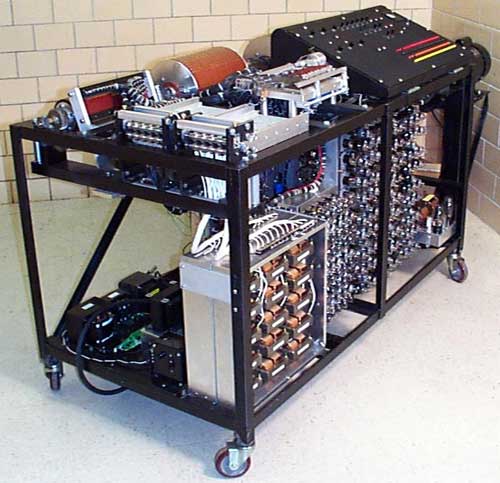
The image featured at the top of this post is ©Unknown author / public domain
